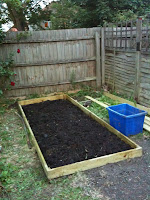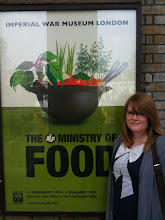I used to love my Nana telling me her stories of the war: I love the fashion, have studied the art of the time and the war time spirit has me gripped.
You can imagine my delight then when the Imperial War Museum opened the doors to it's latest temporary exhibition "The ministry of Food" (see the picture in my profile)
We visited The IWM show in February half term and it is wonderful, I urge you to go if you get the opportunity, it's on until the 3rd of January 2011.
I duly bought the book that accompanies the exhibition and promptly became too busy to cook anything from it - some of the recipes are less enticing than others however I was reminded of my desire to try some war time cooking when the October 2010 issue of Good Food landed on my door mat containing a recipe for the ginger cake Company of Cooks are selling at the Imperial War museum cafe.
I have made it once and it is stunning. I was surprised that there is as much cinnamon as ginger in the cake, and rather a lot of syrup but don't let that put you off!
I am going to try making the cake again this weekend using oil instead of margarine so my little lactose intolerant friend can try a slice - I'll report back on the results.
Kitchen Front Ginger Cake
Cuts into 14-16 slices - hey, families were larger in the 1940's, right?!
Ingredients
- 300g margarine
- 400g Golden Syrup
- 1 egg, beaten
- 130g Plain Flour
- 225 Self Raising flour
- 1 rounded Tsp of Ground ginger
- 1 rounded Tsp of Cinnamon
- A pinch of salt
- 110g soft dark brown sugar
- 1.5 tsp bicarbonate of soda
- 175ml warm water
Method
- Heat the oven to 150 oC, line a 26cm cake tin.
- Gently melt the margarine and syrup in a pan.
- Place the flours, ginger, cinnamon, salt and sugar in a bowl or food mixer.
- Add the margarine and syrup to the dry mix and stir well, then add the egg.
- Disolve the bicarb in the warm water, then pour into the mixture, stirring continuously.
- Pour the mixture into the tin and smooth the top.
- Bake for 1 hour, a skewer inserted into the middle should come out clean. If not; cook for a further 5 minutes and re-try. This can be repeated until done.
- Turn out onto a cake rack to cool.
PS - this post is dedicated to Lucy K who is full of blitz spirit. x








